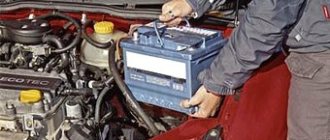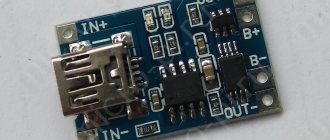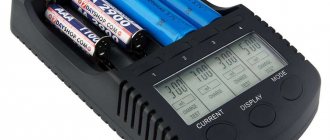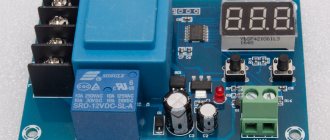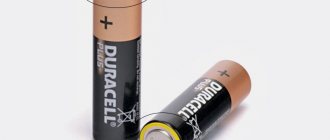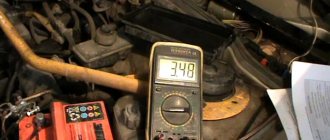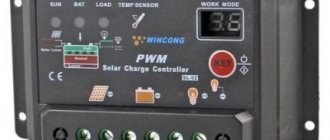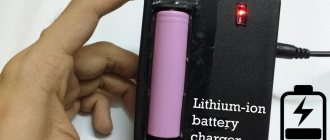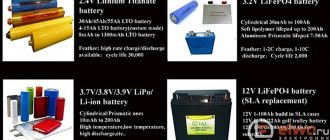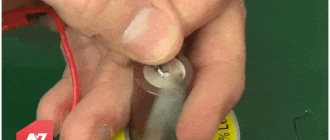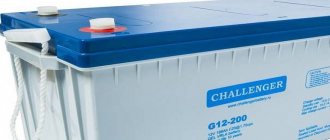The li ion 18650 battery charge controller is a special chip that protects the battery from negative effects caused by charging parameters. This is a mandatory element of the circuit, without which the use of a lithium-ion battery is considered dangerous.
The Li-Ion battery charge controller protects the battery from negative effects when charging parameters change.
Li-ion battery 18650 device
The lithium-ion battery charging controller is produced by corporations: Sony, LG, Sanyo, Panasonic, Samsung, ATL, HYB. Other manufacturers repurchase the elements and pass them off as their own product.
Maximum capacity of ion batteries 18650 – 3600 mAh; they, unlike batteries, can be recharged many times. The number 18650 is a form factor indicating the length of the battery (65 mm) and its diameter (18 mm).
Key Features of 18650 Li-ion Battery:
- the maximum permissible voltage is 4.2 V (small overcharges have a detrimental effect on service life);
- the minimum permissible voltage is 2.75 V (if it drops to 2 V, the charge cannot be restored);
- the minimum permissible temperature is –20 °C 0С (it is impossible to charge in the cold);
- maximum permissible temperature +60 °C 0С (if the indicators are exceeded, explosion and fire are possible);
- Capacity measurement in ampere hours - a full charge produces 1 A of current for 60 minutes, 2 A of current for 30 minutes, 15 A of current for 4 minutes.
A lithium-ion battery converts chemical energy into electrical energy, creating a current that powers a device. Such batteries are equipped with a special protective circuit that controls the level of its heating and operating cycles. If it overheats and the voltage drops to 2.7 V, the controller automatically stops operating the battery.
Li-ion batteries are very explosive, so they have built-in protective circuit boards. A deep discharge of such batteries occurs after 2–3 years of non-use, after which they are problematic to restore and do not have a long service life
.
Is resuscitation possible?
It is potentially possible to reanimate a battery that has suffered a really deep discharge and continue its operation for the benefit of the car.
For this purpose, various methods and instruments are used.
Much depends on how severe the discharge was, how long the battery was in this state, and how many complete discharges the power source experienced before.
Manufacturers usually indicate in the technical documentation the number of deep discharges that a particular liquid lead-acid starter battery can survive.
Typically figures appear in the range of 15–20 cycles. But in reality, even 10 cycles are enough for the battery to no longer perform its functions in winter.
Therefore, the advice is extremely simple.
And there are also batteries that are not at all afraid of such situations.
Purpose of the charging controller
The controller regulates the process of charging and discharging the battery. If the voltage drops below 3 V, the protection disconnects the can from the current consumer: the device turns off. The protective circuit also prevents short circuits. Some types of protective boards have a thermistor that protects battery elements from overheating.
All boards monitor:
- battery overdischarge;
- recharge;
- load current;
- temperature.
Having a protective board on hand, you can convert old screwdriver and drill batteries to lithium batteries, which have a long service life.
Features of the controller for charging li-ion battery 18650
The controller for 18650 lithium batteries is located on top of the case, thereby lengthening the device itself. The board is located in front of the negative terminal, protecting the battery from overcharging/overdischarging. The main producing country is China.
Purpose of the charge controller
Once the protection is installed, the case is placed in a special film with heat shrink. Due to the additional protective structure, the housing becomes longer and thicker, and in rare cases it does not fit into the socket. When using an 18650 battery to create a current of 12 V with a common charge controller, no breakers are installed.
The main function of such protection is to maintain the operation of the energy source within the established parameters.
Types of controllers
Controllers for li-ion batteries differ in price, manufacturer and internal components.
Most Popular:
- HX-3S-A02 (price – 150 rubles). Manufacturer - China, inside is an S-8254AA chip, which protects lithium-ion cells from strong charge/discharge and short circuit. You can connect three 18650 batteries to it (maximum current - 10 A). Protection size – 50x16 mm.
- FDC-2S-2 (price – 50 rubles). Manufacturer – China, chip – HY2120, prevents strong charge/discharge and short circuits. It is possible to connect two 18650 batteries (maximum current - 3A). Protection parameters – 36x6x1 mm.
- HX-2S-01 (price – 70 rubles). Made in China, chip – HY2120, protects against strong charge/discharge and short circuit. Two 18650 batteries are connected (maximum current - 3 A). Protection size – 36x6x1 mm.
- HX-3S-D01 (price – 220 rubles). Made in China, S-8254AA chip, controls strong charge/discharge, short circuit. You can connect three 18650 batteries to it (maximum current - 20 A). The size of the protective board is 51x23 mm.
- HX-3S-D02 (price – 200 rubles). Manufacturer - China, inside the S-8254AA chip, protects against strong charge/discharge and short circuit. Three 18650 batteries are connected to it (maximum current - 10 A). The size of the diagram is 50x16 mm.
- HX-4S-A01 (price – 250 rubles). Manufacturer - China, inside the S-8254AA chip, protects against strong charge/discharge and short circuit. You can connect four 18650 batteries (maximum current - 6 A). The chip size is 67x16mm.
Controller circuits
It is a mistake to think that charge-discharge controllers exist: there is no need to control the discharge, the current is directly dependent on the load. The main thing is to control the voltage and temperature, and the charging completion time. By such a controller we mean a board that protects the battery from deep charging/discharging.
Li-ion battery controller circuit
Microcircuits consist of various electronic elements, so they have variations:
- DW01-Plus. The most popular and simplest microcircuit is located under the self-adhesive with inscriptions that is wrapped around the battery. The board is six-legged, field-effect transistors are connected into one package by an eight-legged assembly. The resistance of the transistors creates a measuring shunt: a large response threshold arises from one device to another. The field devices have built-in parasitic LEDs, thanks to which the battery is charged even when the deep discharge protection is triggered.
- S-8241 Series. The developer of the chip is SEIKO, a company specializing in lithium-ion and lithium-polymer batteries. The protective switches operate at 2.3 and 4.35 volts and when the voltage across FET1-FET2 drops to 200 mV.
- LV5114OT. The protection board operates at 2.5 and 4.25 volts, which prevents overdischarge/overcharge.
- R5421N Series. Average energy consumption in operating condition is 3 μA, at rest – 0.3 μA. This microcircuit has a number of modifications that differ in the magnitude of the response voltage during recharging.
INSTALLATION PROCEDURE
To install the Stop Discharge device, you will need a wrench (usually one wrench per 10 is enough) to loosen and tighten the terminals.
2.1. Loosen the fastening and remove the negative terminal.
2.2. Install and secure the Stop Discharge device on the negative terminal of the battery, and connect the negative cable to the upper terminal, as shown in the picture
ATTENTION !!! Do not over-tighten the battery terminals. The terminal material is quite plastic
Rock the device slightly with one hand while tightening the nut. Stop tightening as soon as the device stops yielding.
2.3. Connect the power cable to the positive terminal of the battery. For example, you can loosen the nut securing the battery pole terminal and fix the contact of the device’s power cable (as shown in the picture above). Again, carefully and without unnecessary effort, tighten the positive terminal of the battery.
Reasons for blocking a li-ion 18650 battery by the controller
The main reason is the occurrence of a short circuit due to exceeding the maximum permissible voltage inside the battery. The microcircuit breaks the electrical circuit. To unlock the battery, just charge it.
The second reason is deep battery discharge. In case of a deep non-critical discharge, the battery can be unlocked using a charger.
If discharged to a critical state, the device will not turn on: internal chemical processes lead to the formation of metallic lithium crystals, which create dangerous contact between the positive and negative poles, leading to an explosion.
What can be used as a load?
The most affordable and easy-to-use option is a 60 W car light bulb. If your pantry has a rheostat designed for loads of about 5 A or more, you can use that too.
The load is connected to the circuit in a series circuit, just like an ammeter. The voltmeter connection is parallel, directly to the battery terminals. Using the rheostat handle, we ensure that the ammeter needle reaches 5 A and observe the voltmeter readings - they should fall below 10 V. The discharge time will depend on many factors, but usually it is a period of 6-12 hours.
The second way to quickly and correctly discharge a car battery is to use one voltmeter, which will act as a load - you just need to connect it and observe the readings. However, this procedure takes a long time due to the low load resistance, so using a powerful repair tester is considered a more preferable option.
The most reliable method is to use a multifunctional factory charger. The charger allows you to discharge batteries of any type, and in automatic mode, without the need for constant monitoring. You only need to enter the initial values of the charging current and voltage at which the device should turn off, informing the driver about the end of the process with a sound signal.
The same charger can also be used for subsequent battery charging. Connecting a powerful load is not recommended - discharge will occur faster, but also with great harm to the battery.
Discharging the battery without removing it from the car
The most primitive method is to turn on any electrical consumer with the engine off: stove, headlight, heated glass. The procedure can only be performed on vehicles that have a voltmeter on the instrument panel. The end of discharge is controlled by its readings, when the battery voltage decreases to 10.9 V.
Discharge using improvised means outside the vehicle
Outside the vehicle, you can use a 60 W car lamp - it will give a discharge current of 5 amperes. You first need to measure the density of the electrolyte - a value of the order of 1.27-1.29 is considered normal.
The lamp is connected in parallel to the circuit, like a multimeter - directly to the battery terminals. Set the device to voltage measurement mode, setting the upper limit to no more than 20 V. Discharge continues under the same conditions - until the voltage drops to 10.9 V. Please note that the lamp will get very hot, place it on a safe place from a fire safety point of view safety material.
Balancing board for li-ion battery 18650
What is the function of the balancer in lithium batteries? If several cells are connected in series, their voltage adds up to a total sum, and the battery capacity is equal to the lowest of all cells.
To prevent the laziest part from overcharging, it is disconnected from power, allowing the remaining parts to continue charging. The balancer controls the uniformly distributed charge, so it is included in circuits with a series connection of elements. With a parallel connection, there is no need for balancing: there is an even charge distribution. The balancing board is usually included in the general protective housing of the MBS and is called a “balancing cable”.
How to restore Li-ion battery
If the battery fails completely, the best solution is recycling; in a situation of extreme necessity, it can be revived in various ways:
- Placing the battery in the freezer: a sudden change in temperature in some cases leads to its temporary start-up. You must keep it in the freezer for 40–50 minutes, then remove it and immediately connect it to the charger for 5 minutes. Wait for the battery to warm up to room temperature and fully charge.
- Opening the battery and disconnecting the protective chip. The procedure is carried out extremely carefully. First, you need to measure the voltage on the contacts with a tester (further actions are possible only if the reading is zero), disconnect the protective board, and measure the voltage readings. Next, connect the charger to the battery for 10–15 minutes, setting the following indicators: 100 mA, 4.2 V. If the battery overheats, the charger should be disconnected. Once it is fully charged, the protective circuit returns to its place.
Before disassembling, look at the release date of the li-ion battery. If he is more than 3-4 years old, you should not try to resuscitate him.
So, the controller for lithium-ion batteries performs an important function - it does not allow the voltage to rise to 4.2 V and drop to 2.75 V (the optimal voltage for a lithium battery is 3.7 volts). Strong discharge and overcharging lead to device failure.
Where do I use lithium batteries?
I converted my screwdriver and electric screwdriver to lithium a long time ago.
I don't use these tools regularly. Now, even after a year of non-use, they work without recharging! I put small batteries in children's toys, watches, etc., where from the element. Where exactly 3V is needed, I add one diode in series and it works just right.
I put them in LED flashlights.
Instead of the expensive and low-capacity Krona 9V, I installed 2 cans in the tester and forgot all the problems and extra costs.
In general, I put it wherever I can, instead of batteries.
